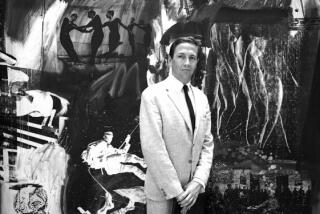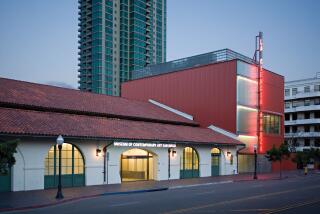Lamenting an Archiveâs Move, for Auld Lang Syne
No matter the emphatic partying or quantities of champagne consumed, yearâs end is invariably a time of reflection and sadness. One remembers what no longer is, and those losses seem to matter more than the yearâs gains or triumphs. So the fact that the announcement came last week that the heirs of Arnold Schoenberg, the great composer, were packing up their late fatherâs manuscripts and shipping them off to Vienna hit particularly hard.
For close to a year we had known that USC would no longer maintain the Schoenberg Institute and that the composerâs family was shopping around for a new site in this country and abroad, but this announcement suddenly made it seem real. And to add a really annoying insult to injury, the city of Vienna made the offer that the family liked best, devoting one floor of the Palais Fanto to the collection.
Vienna was the city in which Schoenberg was born in 1874. And it was in the amazing cultural environment of Vienna that Schoenberg found his voice, a voice that would become the most important one of the century in proscribing the possibilities of a modern music.
But âour loathed and beloved Vienna,â as Schoenberg called it, never made it easy for a composer who was both innovator and Jew. His works, one more revolutionary than the next, were greeted there with derision by audiences and critics. His First Chamber Symphony, now one of his most performed works (the Los Angeles Philharmonic played it in New York and Paris this year to standing ovations), was dubbed the âChamber of Horrors Symphony.â Anti-Semitism was such that Schoenberg, along with a great many noted Viennese Jews, converted to Christianity just as the century was about to turn.
As early as 1911, Schoenberg began to disassociate himself with Vienna, moving to Berlin to teach. After World War I, he settled in Modling, near Vienna, and attempted once more to become part of the cityâs musical life, which remained as hostile as ever. In 1925, he returned to Berlin as a professor at the Prussian Academy of Arts, where he was denounced seven years later for his Jewish heritage.
Schoenberg fled Germany in 1933, reconverted to Judaism in Paris en route to the United States, and eventually settled in Los Angeles, where he lived from 1934 until his death in 1951 at age 76. He taught briefly at USC and then, for eight years, at UCLA. His disciples included John Cage, Lou Harrison and Oscar Levant. He wrote his important late works here. His tennis partner was George Gershwin. His Brentwood home was a few miles from Stravinskyâs in West Hollywood, and although the two dominant figures in the first half of the 20th century had little contact, Stravinskyâs young amanuensis, Robert Craft, did shuttle between the two and brought Schoenbergâs ideas to Stravinsky, who adapted them in his own way.
That Schoenbergâs legacy is connected to Los Angeles goes without saying. That it is also connected to Vienna also is without question. And Schoenberg remained ambivalent toward both cities. As early as 1912, he refused a Vienna professorship by saying he could no longer live in Vienna, because âI expect the very outcome that is the end of every movement in Vienna, a draining away into shallowness.â
In Los Angeles he was celebrated but felt unappreciated. âThese people who have been suppressing my works in this part of the world for the last 25 years now want to use me as decoration,â he wrote Otto Klemperer, then music director of the Los Angeles Philharmonic, âbecause I simply happen to be here.â But the fact is, Schoenberg became one of us. His two sons, Ronald and Lawrence, were born here and have become prominent local citizens--the former a Municipal Court judge and the latter now a retired teacher. His daughter, Nuria, who now lives in Venice, Italy, was 2 years old when Schoenberg left Europe, and she also grew up here.
The Schoenberg Institute, too, is a part of us. The archive, which contains the composerâs scores, sketches, letters, paintings and various other materials, is as much a history of Los Angeles as it is of Vienna and Berlin. And it is more--a testament to political freedom. Left to Nazis in Vienna, these materials would have probably been burned.
It is no use assigning blame at this point. The Schoenberg family wants the institute exclusively devoted to Schoenberg, rather than letting it become a center for wider musical performances and conferences. USC wants to use the neo-Bauhaus building, which the family raised the funds to build, for its own purposes.
So now, if the family signs the papers in Vienna, as it says it will do in a monthâs time, the collection will leave USC, and the school will have the building to do with as it pleases. Vienna, which has never honored Schoenberg and still doesnât in anything more than name, will have a great publicity coup.
But what will USC tell its students? The building it wants so badly for classrooms is too architecturally different from all else on campus to be anything but the Schoenberg Institute. How will it explain to future generations that, for a small piece of real estate, it sold out a significant part of Los Angelesâ musical heritage?
It is not too late for minds to be changed. Maybe nothing can undo the animosity that persists between the Schoenbergs and USC--although the school might learn a lesson in magnanimity from Thomas Mann, who through a kind letter was able to graciously end a feud with the pigheaded composer who had taken umbrage at a character portrayed in Mannâs novel âDoctor Faustus.â Still Vienna isnât the only offer. Bard College, in New York State, may not have Viennaâs resources or its glamour, but it has offered to meet the basic conditions.
The Schoenbergs have succumbed to what they feel is best for the collection, not our city or our country. They are wary of American institutions after what they perceive USC has done to them in not honoring its agreement to maintain the collection as they see fit in perpetuity. But promises from governments are probably the least certain assurances of all.
More to Read
The biggest entertainment stories
Get our big stories about Hollywood, film, television, music, arts, culture and more right in your inbox as soon as they publish.
You may occasionally receive promotional content from the Los Angeles Times.











